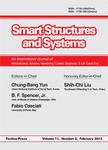版权所有:内蒙古大学图书馆 技术提供:维普资讯• 智图
内蒙古自治区呼和浩特市赛罕区大学西街235号 邮编: 010021

作者机构:Shahid Chamran Univ Dept Mech Engn Ahvaz 61357 Iran Dept Mech Engn Mech Engn Mahshahr 63518 Iran
出 版 物:《SMART STRUCTURES AND SYSTEMS》 (Smart Struct. Syst.)
年 卷 期:2015年第15卷第5期
页 面:1233-1252页
核心收录:
学科分类:08[工学] 0804[工学-仪器科学与技术] 0802[工学-机械工程] 0813[工学-建筑学] 0814[工学-土木工程]
主 题:crack detection beam vibration postbuckling differential quadrature method bees algorithm
摘 要:This study investigates the problem of crack detection in post-buckled beam-type structures. The beam under the axial compressive force has a crack, assumed to be open and through the width. The crack, which is modeled by a massless rotational spring, divides the beam into two segments. The crack detection is considered as an optimization problem, and the weighted sum of the squared errors between the measured and computed natural frequencies is minimized by the bees algorithm. To find the natural frequencies, the governing nonlinear equations of motion for the post-buckled state are first derived. The solution of the nonlinear differential equations of the two segments consists of static and dynamic parts. The differential quadrature method along with an arc length strategy is used to solve the static part, while the same method is utilized for the solution of the linearized dynamic part and the extraction of the natural frequencies of the cracked beam. The investigation includes several numerical as well as experimental case studies on the post-buckled simply supported and clamped-clamped beams having open cracks. The results show that several parameters such as the amount of applied compressive force and boundary conditions influences the outcome of the crack detection scheme. The identification results also show that the crack position and depth can be predicted well by the presented method.